Microgreens are highly nutritious and add exciting flavors, textures and colors to dishes. But what can you do with them other than adding them to salads? You don’t need to be a high-end chef to learn to use microgreens in your kitchen. I have found 17 different ways you can use microgreens from sandwiches and omelettes to sauces and desserts.
When it comes to cooking with microgreens, they can serve three major functions, in addition to increasing the nutrient content of your meals. First, they can provide unique flavors. They can be used instead of spices to enliven dishes. Mustard, radish, arugula, and turnip are good choices.
Second, they can add crunchy texture and replace sprouts, lettuce or other salad greens. If crunch is all you are going for, mild flavored microgreens such as sunflower, pea, bok choy and napa cabbage are your best options.
Third, microgreens can add splashes of color to garnish any dish. The deep green color of kale and cabbage, or the red of beet and arugula, or the pink of radish, and the purple of cabbage or radish provide a great variety for the artistically inclined cook.
Finally, you can take advantage of two or all three characteristics of microgreens to decorate and spice up your recipes. The great thing about microgreens is that you don’t have to come up with new recipes. You can add them to most type of common dishes. So let’s see some examples of how they can jazz up your meals.
1. Salad
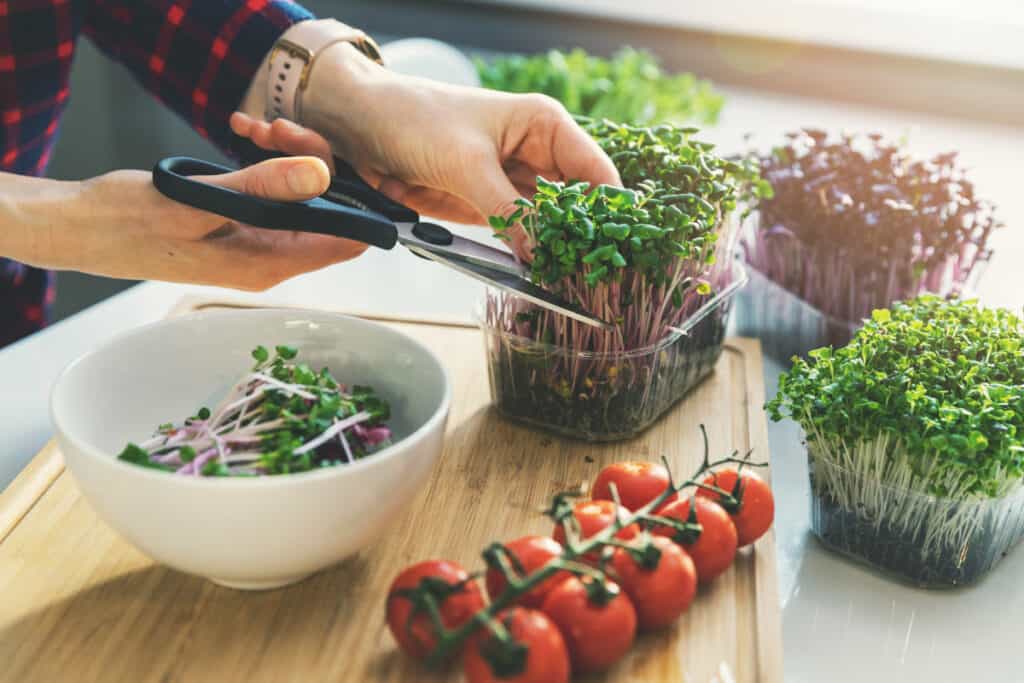
Salads are the most obvious choice for using microgreens, because microgreens are similar to salads greens: they are green, raw, and crunchy; they are just smaller. Microgreens are great to add to other salad greens or replace them entirely.
Sunflower greens are a great choice because of their mild and crunchy flavor. They can be substituted for any other salad green. Other spicier greens such as radish and mustard can be used in smaller quantities to add a burst of flavor. You don’t want to overdo these spicy ones; it’s best to have a milder tasting vegetable as the base of the salad.
Microgreens are also great with non-lettuce based salads such as beets and other root vegetables, or roasted butternut squash. Another great combination is cucumbers, tomatoes, avocados, and microgreens. Again, if you use microgreens as the base of the salad, make sure not to include ones with strong flavors or they can overpower your salad. You can use a combination of sunflower or pea shoots, and add some arugula, radish, red cabbage or other spicy microgreen.
2. Sandwiches, Wraps and Burgers
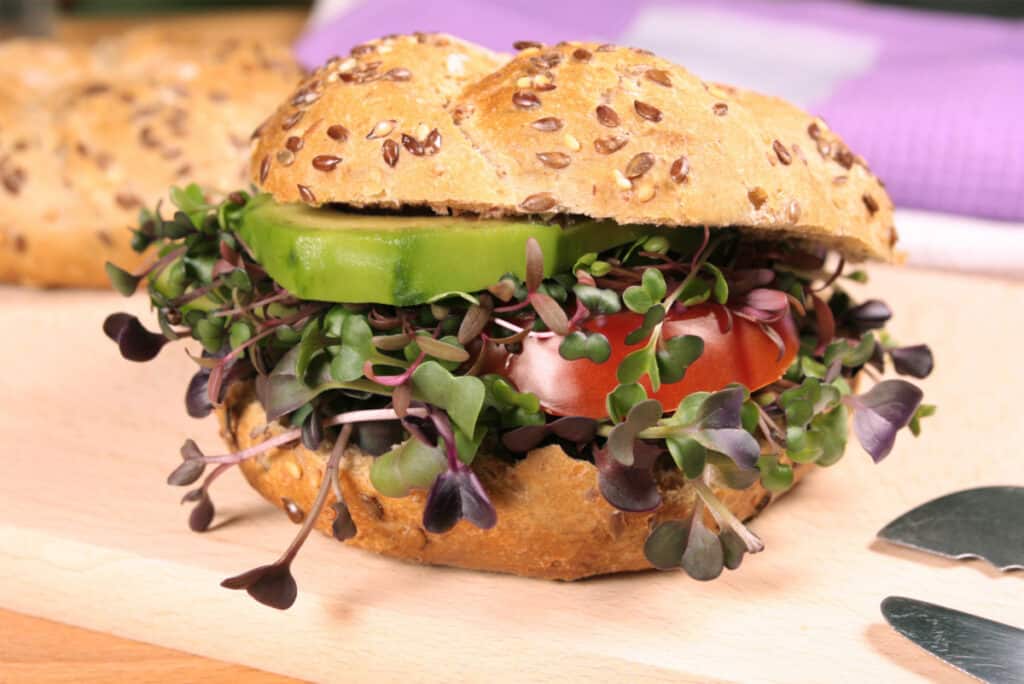
Another obvious use for microgreens is in sandwiches, wraps and burgers. Microgreens can replace boring lettuce in any sandwich or substitute for sprouts. They come in a wider variety of flavors than lettuce, so they can add crunch and/or spicy flavor. The other thing I like about using microgreens in sandwiches and wraps is that they are small so it’s easy to bite into them. In fact you don’t even have to bite them; the are so small. Try your BLT next time with sunflower greens instead of lettuce, you might be surprised how well it substitutes for lettuce. Or try arugula for a spicier version.
You can use microgreens for open-faced sandwiches too. In this case, their decorative appeal can be greatly emphasized. You can use different color microgreens, or one that contrasts with the rest of the ingredients on the sandwich.
Grilled sandwiches can also include microgreens, even grilled cheese sandwiches. Make sure to add the microgreen at the last step, so they don’t wilt, and remain crunchy. Hamburgers can also benefit from some tasty microgreens such as onion or radish.
3. Toast
If you like savory breakfasts, toast is a versatile medium for many kinds of topping from simple to complex, from vegan to carnivore.
You can put anything on the toast and a sprinkling of microgreens will improve both the look and flavor. Try goat cheese, avocado, fried egg, humus, eggplant, roasted peppers, liver pate, tuna, egg salad, and whatever you can think of. Again, you can go for flavor, color or both when you choose your microgreens.
4. Nachos and Tacos
Just like with toast and sandwiches, you can add microgreens on nachos and tacos to replace iceberg lettuce, which other than it’s crunchiness, doesn’t have much going for it. Use colorful microgreens to add more flavor, interest and nutrition. If you are adding them to nachos, add them after you have taken them out of the oven.
5. Pizza
While we are talking about toppings for toast and nachos, we might as well add them to pizza. You can use traditional flavors such as arugula, or basil microgreens, and add them after you have taken the Pizza out of the oven. You can also use a spicy mix if you have a mild-flavored pizza. Any microgreen with a green color will look great on a pizza with tomato sauce and cheese. If you have a pesto-based green colored pizza, you can try red beet or amaranth microgreens for a different color.
6. Pasta
Let’s talk about another Italian favorite that also pairs with microgreens really well. Especially if you are making your pasta Italian style, which means the pasta is not swimming in the sauce, but just lightly coats the noodles. Especially white sauces will work well, like a cream-based sauce such as lemon sauce. Goat cheese, gorgonzola, an other cheese sauces will also be great. Since they are white, they will take any color microgreen. Classic arugula will always work, but I would try some of the cabbage family microgreens such as broccoli, kale and cabbage. Again you would add the microgreens last minute, when the pasta is already plated.
Non-Italian pasta dishes can also be adorned with microgreens. Asian noodles are great candidates for peat shoots, radish, cabbage, and broccoli, and the variety of Asian greens such as bok choy, napa cabbage, and komatsuna You can sprinkle on the microgreens at the end, or stir-fry them for a few minutes. I especially like to stir-fry pea shoots and sunflower greens just for a couple of minutes with some olive oil and soy soy sauce, and then mix in the noodles.
7. Sushi
Now that we have moved on to Asian cuisine, how about adding some microgreens to sushi. This is one of my favorite way to use microgreens. When it comes to vegetarian sushi, the standard fillings get pretty boring after a while. I get tired of the same California roll with avocado, cucumber, and carrots.
So I tried adding some sunflower microgreens, because that’s what I had on hand, and I really liked them. The beauty of microgreens in sushi is that they are already small, so you don’t have to slice them thin. They are so small and easy to arrange on a sushi roll.
With sushi, the visual appeal is important, so you can again experiment with different colors. I think spicy microgreens will also go well with sushi, such as radish and mustard. There is even a microgreen called Wasabi mustard if you really want to keep the Asian theme.
You can wrap the microgreens inside the rolls with the rest of the fillings, or you can decorate the cut rolls with a sprinkling of microgreens. This method will also work for fish sushi.
8. Burgers and Veggie Patties
Being a vegetarian, I like to make burgers from a variety of ingredients such as quinoa, chickpeas and lentils. I also like to make patties from zucchini, beets, yams, and turnips. When I have some of the smaller and thinner microgreens on hand, I like to throw some into the burger mix before I fry them. I like red cabbage particularly, because it’s one of the healthiest ones, and I can’t eat too much of it raw; but mixed in with the burgers they add an nice contrast in color.
9. Stir Fry
Stir frying is one of my favorite ways to cook microgreens, especially sunflower greens and peat shoots. Stir-frying doesn’t work so well for the more delicate, thinner microgreens. They just become limp and flavor-less. But larger microgreens, including bean and pea microgreens do really well in a stir-fry. You can add them to a mixed vegetable stir-fry, or make one quick one just using microgreens. They only need a few minutes to cook. You can add some soy sauce or hot sauce and serve it with rice or noodles.
10. Casserole
Casserole is another dish that can be decorated and flavored with any microgreen. A sprinkling of arugula or broccoli microgreens on mac and cheese would dress up this dish nicely. You can add them after you have taken the dish out of the oven. If you are using sunflower greens, you can try adding them a few minutes before the baking is done, so that the greens can cook and soften a bit.
11. Omelette
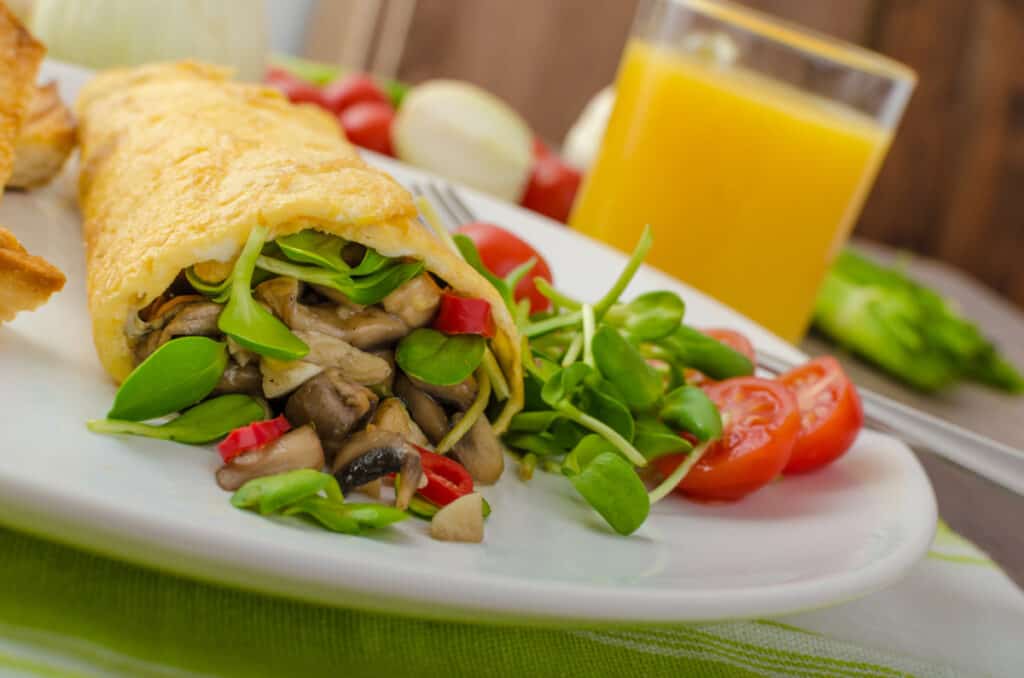
I find omelettes one of the best choices for microgreens for several reasons. You don’t need to cook omelettes very long, so you can add the microgreens to the stirred eggs and cook them all together. In addition, they add a nice splash of green color, so you can use them instead of spinach or basil, or any other green you would normally use. Add some red peppers for more color.
Another way of using microgreens with eggs is to fill the already cooked omelette with microgreens along with cheese and avocado. Or sprinkle them on top.
12. Grains
Cooked grains such as rice, quinoa and millet can be boring. But microgreens are an easy way to decorate them and to add more nutrition. After the grains finished cooking, you can stir in the microgreens just before serving. Or sprinkle them on the plate.
Microgreens are also great it grain salads. In this case, cool the grains first, before stirring in the microgreens. Small, delicate microgreens would work great here such as cabbage, radish, kale, arugula, broccoli, basil or any other herb.
13. Soups
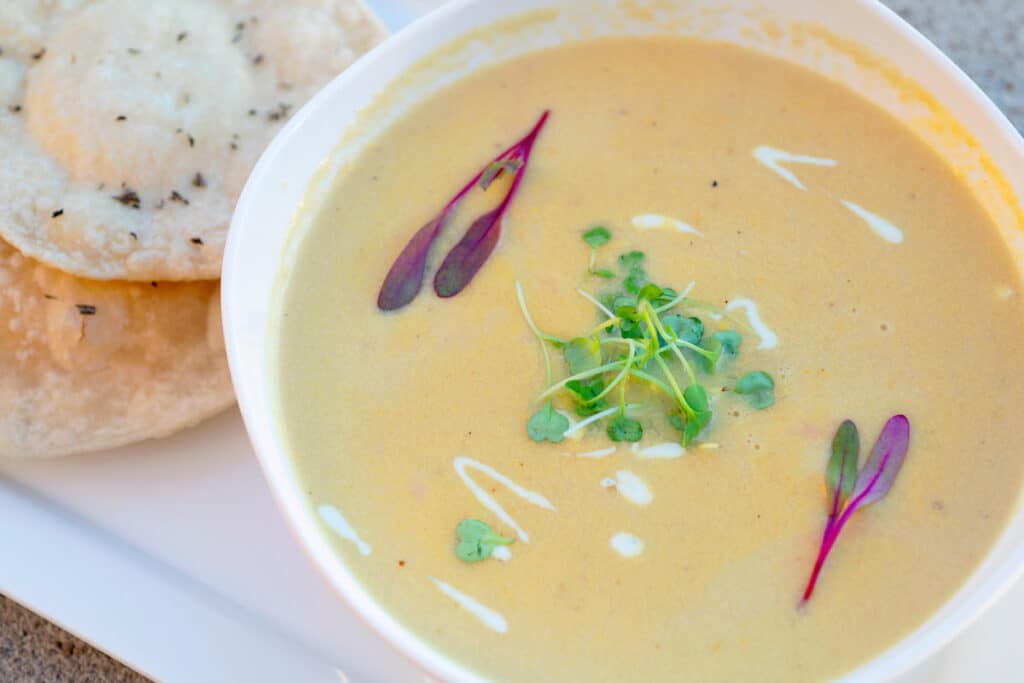
I was surprised how well microgreen go with soups. The easiest way to use them is to decorate your bowl of soup with a sprinkling of microgreens. Spicy microgreens such as radish and mustard are great to liven up a vegetable or bean soup.
Another way to use microgreens is to add them into the soup just after you turn off the heat. The other day, I made a Thai inspired coconut curry soup with yams and red peppers. When the soup finished cooking in the Instant Pot, I added some chopped sunflower microgreens and let them sit in the soup for 5 minutes. They had the perfect texture, not to crunchy and added a wonderful green to the orange-colored soup.
You can also add fresh microgreens to any cream soup, and blend them in with the cooked ingredients. You will get an extra boost of flavor and nutrition. In addition, you can use the same microgreens to decorate the cream soup as you wold decorate any other soup.
14. Pesto, Salsa and Guacamole
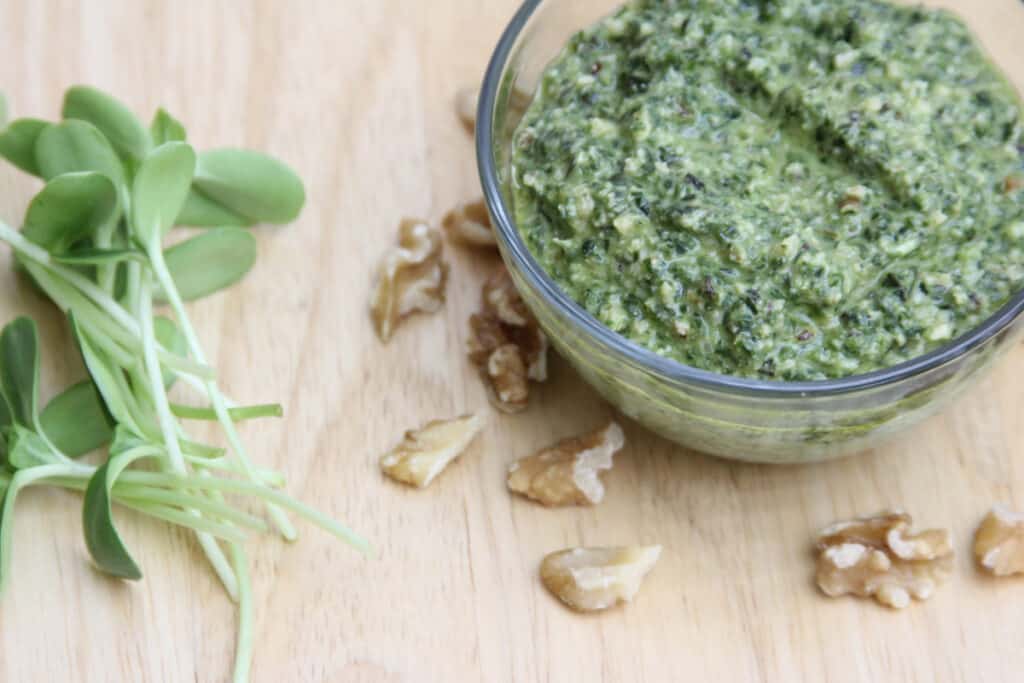
Microgreens can be added to a variety of raw sauces including pesto, guacamole and salsa. When you make pesto, you can simply replace some, or all of the basil with sunflower microgreens. I would personally keep it to 50 percent basil and 50 percent sunflower microgreens to maintain the intense flavor of basil. Another option is to combine a variety of microgreens. For example sunflower and arugula microgreens would make a good combination and the spicy flavor of arugula would replace the flavor of basil. Simply chop the microgreens in a food processor and add olive oil, walnuts or pine nuts, and parmesan cheese.
Guacamole can also be spiced up with microgreens. Again, it will depend on you taste. Herbs would work well such as cilantro and basil, or arugula and sunflower. Chop the microgreens fine and mix in with the rest of the ingredients.
Green salsa, or salsa verde, is another sauce ready for microgreens. Just blend in the microgreens with the rest of the ingredients such as tomatillos, peppers and lime juice. Sunflower microgreens will work well, or you can experiment with stronger flavors.
15. Dessert
If you like to garnish your desserts, microgreens are perfect for you. Here we are going for color and more subtle flavors, so sweet microgreens such as pea, basil, purple basil, beet would work really well. They also have different colors from red, purple and green so they will add visual interest to desserts. Some easy candidates are ice cream, tart, pudding, and fruit salad.
Edible flowers also combine well with microgreens in garnishes, so you can make some creative arrangements on top of a cake, or on a plate around the dessert.
16. Smoothie
Green smoothies are already very nutritious and you can make them even more nutritions by adding microgreens. Since microgreens pack in more nutrition per weight than adult vegetables, by replacing the spinach or kale in your green drink, you can double or triple your vitamin and antioxidant intake. If you like milder flavors, use pea or sunflower greens. Beet microgreens are also super healthy. If you don’t mind more pungent or bitter tastes, you can add any microgreen. Sweeten your smoothie with bananas or mangoes to compensate for the healthy taste of microgreens.
17. Juice
If you like to drink your nutrition, microgreens can also be juiced. Although I am not sure about the juice content of microgreens, they can definitely add flavor and nutrition. I am not sure this is the best way to take advantage of the wonderful color, texture or flavor of microgreens, but if you must drink your vegetables, microgreens can be juiced. Combine microgreens with apple, pear cucumber, pineapple, celery, lemon or lime to make a refreshing nutrient-dense drink.
Summary
As you see, there is no limit to using microgreens in the kitchen. If you are only using them to garnish you dishes, they will enliven anything from baked potatoes, fish, and curry to crepes and grilled vegetables. Once you start cooking with them, you will find more and more uses for them. Only your creativity is the limit.
Since there are dozens of varieties of microgreens, you can experiment with them to see which one fits a certain dish better. Microgreens are the best all-around superfoods because they are fresh, highly nutritious, and can be used in so many ways. I hope this list has inspired you to start using and even growing your own microgreens. They can be grown inside your home to provide you with the freshest taste and greatest amount of nutrition.

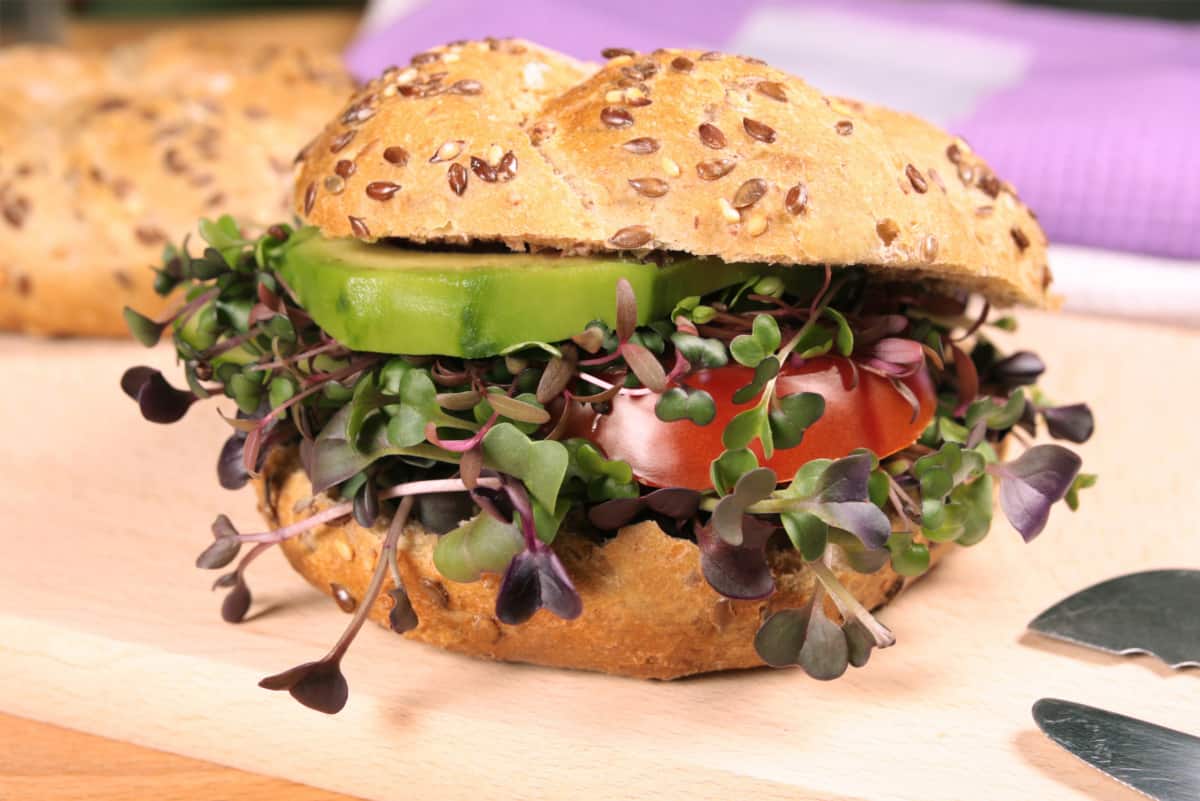

Leave a Reply